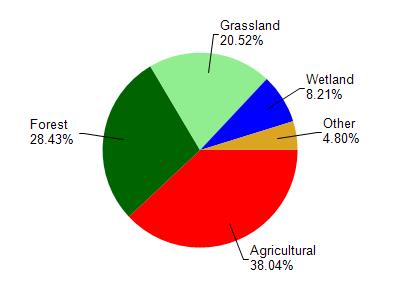Barron
No
No
No
Fish and Aquatic Life
Overview
Barron Flowage No.1, in the Yellow River Watershed, is a 52.47 acre lake that falls in Barron County. This lake is managed for fishing and swimming and is currently not considered impaired.
Date 2011
Author Aquatic Biologist
Historical Description
Source: 1964, Surface Water Resources of Barron County Barron Flowage #1 T34N, R12W, Section 27
A hard water drainage lake on the Yellow River in the City of Barron. The flowage is formed by a 13 -foot impounding structure on its outlet which is a public utility dam operated by the City of Barron. The flowage is managed for northern pike, bass and panfish. The most abundant fish species are bullheads, followed by northern pike, largemouth bass, bluegills, black crappies and pumpkinseeds, walleyes, smallmouth bass, rock bass, brook trout and white suckers. An acre of marshy wetlands provides habitat for muskrats and a few ducks. Public access with limited parking is located near the dam. There is a small park with a picnicking area near the access. Public frontage consists of 2, 000 feet of city frontage. Private development is made up of three dwellings.
Surface Acres = 47.0, S.D.F. = 2.60, Maximum Depth = 13 feet
Date 1964
Author Surface Water Inventory Of Wisconsin
Condition
Wisconsin has over 84,000 miles of streams, 15,000 lakes and milllions of acres of wetlands. Assessing the condition of this vast amount of water is challenging. The state's water monitoring program uses a media-based, cross-program approach to analyze water condition. An updated monitoring strategy (2015-2020) is now available. Compliance with Clean Water Act fishable, swimmable standards are located in the Executive Summary of Water Condition in 2018. See also the 'monitoring and projects' tab.
Reports
Management Goals
Wisconsin's Water Quality Standards provide qualitative and quantitative goals for waters that are protective of Fishable, Swimmable conditions [Learn more]. Waters that do not meet water quality standards are considered impaired and restoration actions are planned and carried out until the water is once again fishable and swimmable
Management goals can include creation or implementation of a Total Maximum Daily Load analysis, a Nine Key Element Plan, or other restoration work, education and outreach and more. If specific recommendations exist for this water, they will be displayed below online.
Monitoring
Monitoring the condition of a river, stream, or lake includes gathering physical, chemical, biological, and habitat data. Comprehensive studies often gather all these parameters in great detail, while lighter assessment events will involve sampling physical, chemical and biological data such as macroinvertebrates. Aquatic macroinvertebrates and fish communities integrate watershed or catchment condition, providing great insight into overall ecosystem health. Chemical and habitat parameters tell researchers more about human induced problems including contaminated runoff, point source dischargers, or habitat issues that foster or limit the potential of aquatic communities to thrive in a given area. Wisconsin's Water Monitoring Strategy was recenty updated.
Grants and Management Projects
Monitoring Projects
| WBIC | Official Waterbody Name | Station ID | Station Name | Earliest Fieldwork Date | Latest Fieldwork Date | View Station | View Data |
|---|
| 2096700 | Barron Flowage No. 1 | 033029 | Yellow River - Below Dam R.Mi-6.0 | | | Map | Data |
| 2096700 | Barron Flowage No. 1 | 033026 | Yellow River - Jerome Foods Inc Barron 002 | 8/20/1979 | 8/20/1979 | Map | Data |
| 2096700 | Barron Flowage No. 1 | 10000766 | Barron Flowage # 1 | 9/5/2000 | 10/3/2016 | Map | Data |
| 2096700 | Barron Flowage No. 1 | 033025 | Yellow River - Jerome Foods Inc Barron 001 | 8/11/1977 | 1/30/1985 | Map | Data |
| 2096700 | Barron Flowage No. 1 | 10020150 | Barron Flowage/Yellow River -- Access Nr U.S. Hwy 8 | 9/10/2003 | 9/27/2007 | Map | Data |
| 2096700 | Barron Flowage No. 1 | 033027 | Yellow River - Jerome Foods Inc Barron 003 | 7/1/1981 | 7/1/1981 | Map | Data |
| 2096700 | Barron Flowage No. 1 | 033023 | Yellow River - Barron Electric Barro | | | Map | Data |
| 2096100 | Yellow River | 10020150 | Barron Flowage/Yellow River -- Access Nr U.S. Hwy 8 | 9/10/2003 | 9/27/2007 | Map | Data |
|

Watershed Characteristics
Barron Flowage No. 1 is located in the Yellow River watershed which is 239.35 mi². Land use in the watershed is primarily agricultural (38%), forest (28.40%) and a mix of grassland (20.50%) and other uses (13.00%). This watershed has 415.31 stream miles, 2,929.80 lake acres and 11,565.29 wetland acres.
Nonpoint Source Characteristics
This watershed is ranked High for runoff impacts on streams, Not Available for runoff impacts on lakes and High for runoff impacts on groundwater and therefore has an overall rank of High. This value can be used in ranking the watershed or individual waterbodies for grant funding under state and county programs.However, all waters are affected by diffuse pollutant sources regardless of initial water quality. Applications for specific runoff projects under state or county grant programs may be pursued. For more information, go to surface water program grants.